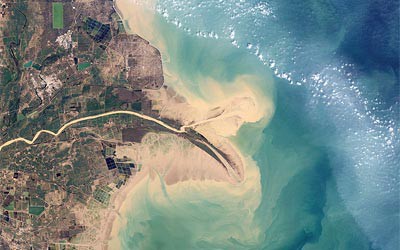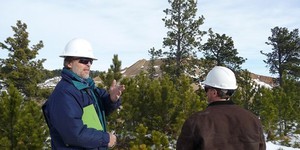Log In
Summary

*Note:
For this science project you will need to develop your own experimental procedure. Use the information in the summary tab as a starting place. If you would like to discuss your ideas or need help troubleshooting, use the Ask An Expert forum. Our Experts won't do the work for you, but they will make suggestions and offer guidance if you come to them with specific questions.
If you want a Project Idea with full instructions, please pick one without an asterisk (*) at the end of the title.
If you want a Project Idea with full instructions, please pick one without an asterisk (*) at the end of the title.
Abstract
Silt is a fine sediment that collects on the bottoms of rivers, streams and lakes. The natural process of the decay of organisms into the water can lead to the production of silt at the bottom of a lake. Silt can be a rich source of nutrients for fish and bottom dwellers like crayfish. However, it can also be introduced by unnatural processes. One problem for rivers, lakes and streams is the buildup of excess fine sediment introduced by industry. Because it often contains harmful chemicals it can turn a beautiful clear lake into a brown, contaminated, sludge-filled pond. Silt can be introduced into streams and lakes by mining, agriculture, other industries, and sewage. Test an aquatic environment for the presence of silt. Is it above or below normal levels? Can you test upstream and downstream of a potential industrial site? Do the types of organisms you find change in areas with an excess silty bottom? Use a water test kit to test for the presence of contaminants. Are the contaminants enriched in silty lakes compared to clear lakes? Study the silt under a microscope; is the silt layer enriched with micro-organisms? (NPS, 2006; EPA, 2006)Bibliography
- EPA, 2006. U.S. Environmental Protection Agency. Washington, D.C. Retreived March 1, 2006.
- NPS, 2006. National Park Service. Washington, D.C. National Park Service, U.S. Dept. of the Interior. Retreived March 1, 2006.
Ask an Expert
Do you have specific questions about your science project? Our team of volunteer scientists can help. Our Experts won't do the work for you, but they will make suggestions, offer guidance, and help you troubleshoot.
Global Connections
The United Nations Sustainable Development Goals (UNSDGs) are a blueprint to achieve a better and more sustainable future for all.
This project explores topics key to Life Below Water: Conserve and sustainably use the oceans, seas and marine resources.
Careers
If you like this project, you might enjoy exploring these related careers:
Career Profile
Our environment on planet Earth is made up of the air, water, and land. Environmental compliance inspectors work to protect and preserve our environment and the public by making sure communities, individuals, businesses, and state and local governments are in compliance with pollution laws and regulations.
Read more
Career Profile
Ever wondered what wild animals do all day, where a certain species lives, or how to make sure a species doesn't go extinct? Zoologists and wildlife biologists tackle all these questions. They study the behaviors and habitats of wild animals, while also working to maintain healthy populations, both in the wild and in captivity.
Read more
Career Profile
Think of all the jobs in the world that involve machinery, chemicals, toxins, radiation, loud noise, or travel to places above or below Earth's surface—all of these jobs carry an element of risk to the workers. Industrial health and safety engineers work to minimize this risk. They inspect work sites and help workers and companies understand and comply with safety laws. They use their knowledge of mechanical processes, chemistry, and human psychology and performance to anticipate…
Read more
Career Profile
Have you ever noticed that for people with asthma it can sometimes be especially hard to breathe in the middle of a busy city? One reason for this is the exhaust from vehicles. Cars, buses, and motorcycles add pollution to our air, which affects our health. But can pollution impact more than our health? Cutting down trees, or deforestation, can contribute to erosion, which carries off valuable topsoil. But can erosion alter more than the condition of the soil? How does an oil spill harm fish…
Read more
Related Links
Cite This Page
General citation information is provided here. Be sure to check the formatting, including capitalization, for the method you are using and update your citation, as needed.MLA Style
Science Buddies Staff.
"Silt Deposits in Streams." Science Buddies,
18 July 2020,
https://www.sciencebuddies.org/science-fair-projects/project-ideas/EnvSci_p035/environmental-science/silt-deposits-in-streams?class=AQW7tzVHAEdiPfrrU3h0cPrZkZaCLGE0_8r05OpYRNVXak-UhP_1nUaDpszPWRgVq9k47UZdhwGIZDsil2ikNN7BmgGkuxkESMZ86mjom1mayw.
Accessed 25 Apr. 2024.
APA Style
Science Buddies Staff.
(2020, July 18).
Silt Deposits in Streams.
Retrieved from
https://www.sciencebuddies.org/science-fair-projects/project-ideas/EnvSci_p035/environmental-science/silt-deposits-in-streams?class=AQW7tzVHAEdiPfrrU3h0cPrZkZaCLGE0_8r05OpYRNVXak-UhP_1nUaDpszPWRgVq9k47UZdhwGIZDsil2ikNN7BmgGkuxkESMZ86mjom1mayw
Last edit date: 2020-07-18
Explore Our Science Videos
See Germs! Hand Washing Science Experiment
Strawberry DNA Extraction
Racing Drones: Does Practice Make you Faster?












